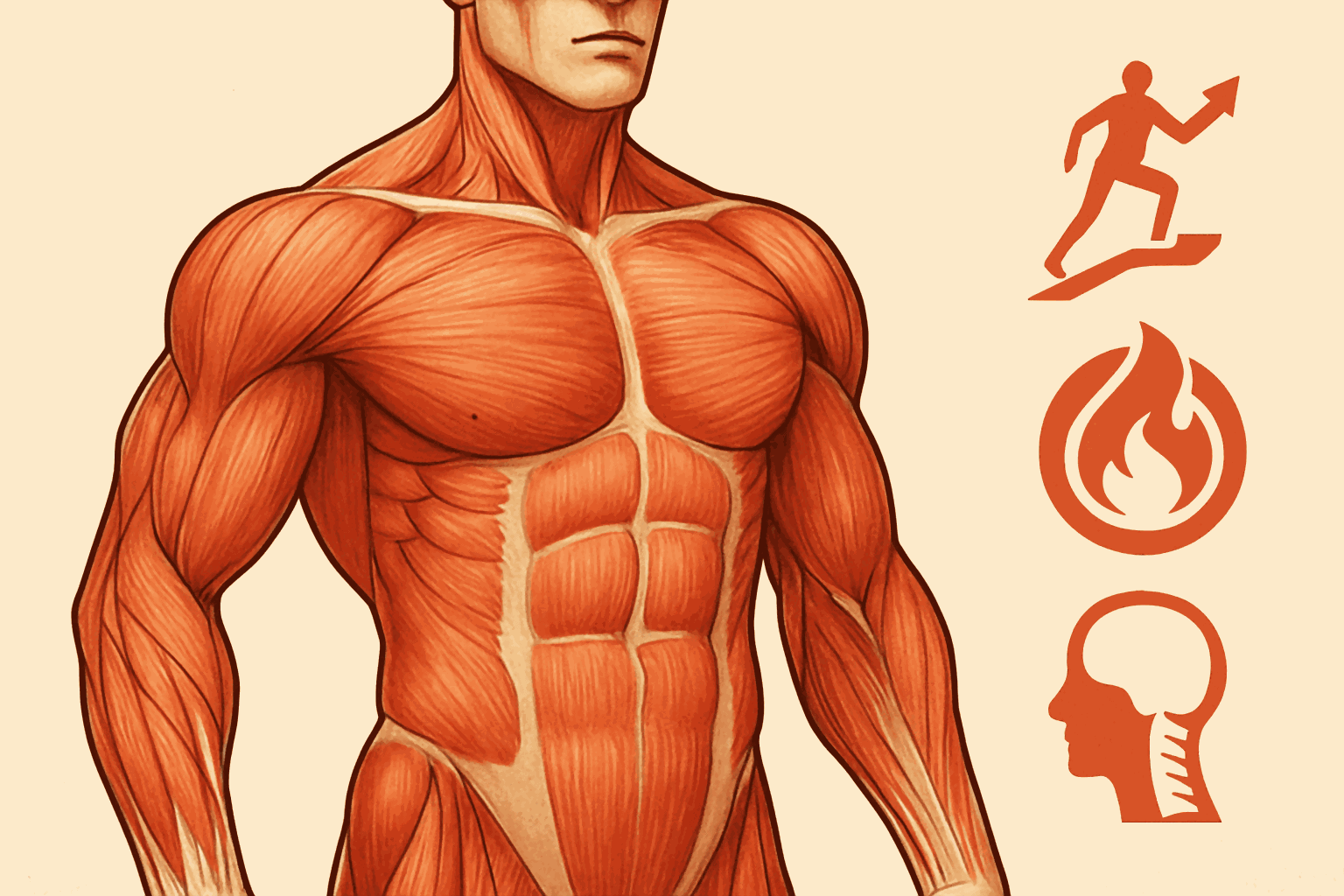
The Unseen Powerhouse: Why Building and Maintaining Skeletal Muscle is Crucial for Lifelong Health
- Marcus Reed
- Health , Fitness , Physiology , Longevity
- May 7, 2025
Table of Contents
Skeletal muscles: often, we associate them primarily with movement – lifting, walking, running. While this is undeniably a core function, the true significance of these remarkable tissues extends far deeper, influencing nearly every aspect of our health and well-being. Today, we delve into the science-backed reasons why building and strengthening your skeletal muscles is not just about aesthetics or athletic prowess, but a fundamental investment in your long-term vitality.
More Than Just Movement: The Multifaceted Roles of Skeletal Muscle
Skeletal muscles are not passive bystanders in our physiology; they are dynamic, metabolically active organs crucial for maintaining overall health and homeostasis. Their importance can be understood through several key functions:
1. The Metabolic Engine: Fueling Your Body Efficiently
Muscle tissue is a metabolic powerhouse. It plays a critical role in:
- Basal Metabolic Rate (BMR): The more muscle mass you have, the higher your BMR. This means your body burns more calories at rest, which is crucial for weight management and preventing obesity-related conditions [1, 2].
- Glucose Regulation: Skeletal muscle is the primary site for insulin-mediated glucose uptake. Healthy muscle tissue improves insulin sensitivity, helping to regulate blood sugar levels and reduce the risk of type 2 diabetes [3, 4]. During and after exercise, muscles can also take up glucose without the need for insulin, further highlighting their role in glycemic control.
2. The Neuromuscular Connection: Orchestrating Movement and Adaptability
Every intentional movement you make is a symphony conducted by your nervous system and performed by your muscles.
- Coordination and Control: The central and peripheral nervous systems intricately connect with muscle fibers, forming motor units. This neuromuscular connection allows for precise, coordinated muscle contractions necessary for everything from fine motor skills to complex athletic movements [5].
- Adaptation to Physical Exertion: Strength training not only builds muscle but also enhances this neuromuscular communication, improving efficiency, strength, and the ability to learn new motor patterns [6].
3. A Bulwark Against Aging: Muscle Strength as a Longevity Marker
As we age, we naturally tend to lose muscle mass and strength, a condition known as sarcopenia [7]. This loss is associated with a decline in functional ability, increased risk of falls and fractures, and overall frailty.
- Predictor of Healthy Aging: Maintaining muscle strength is a key indicator of how well we age. Studies have shown a strong correlation between muscle strength and longevity [8]. For instance, the simple ability to get up from the floor without using your hands (often assessed by tests like the “sitting-rising test”) has been linked to mortality rates in older adults, underscoring the importance of functional strength [9, 10].
- Combating Sarcopenia: Resistance exercise is the most effective intervention to counteract sarcopenia, helping to preserve muscle mass, strength, and function well into older age [11].
4. The Foundation of Good Posture: Supporting Your Frame
Your muscular system is the primary support structure for your skeleton, playing a vital role in maintaining posture.
- Structural Support: Core muscles, including those in your abdomen, back, and pelvis, provide stability for your spine. Strong, balanced musculature helps maintain an upright posture, which can prevent chronic pain and improve biomechanical efficiency [12].
- Impact on Overall Well-being: Good posture, facilitated by strong muscles, can positively affect breathing mechanics by allowing full lung expansion, enhance alertness, and even contribute to a more confident psychophysiological state. Conversely, weak postural muscles can lead to slouching, back pain, and compromised respiratory function [13].
5. Aesthetics Meet Functionality: The Dual Benefit of Developed Musculature
While the pursuit of a toned physique is a common motivator for exercise, the benefits of developed musculature go far beyond appearance.
- Enhanced Functional Capacity: Stronger muscles mean greater ease in performing daily activities – carrying groceries, climbing stairs, playing with children. This “functional fitness” significantly improves quality of life [14].
- Improved Body Composition: Building muscle increases lean body mass and can help reduce body fat percentage, contributing to a healthier body composition and reducing the risk of various chronic diseases [2]. The quality of muscle tissue, not just quantity, is also linked to improved physical condition and overall vitality.
Charging Your Power Supply: Principles for Building and Maintaining Muscle
Our brain may be the processor, but our muscles are indeed the power supply that enables us to interact with the world and maintain our health. “Charging” this power supply effectively involves several key principles:
- Progressive Resistance Training: Regularly challenge your muscles by lifting weights, using resistance bands, or performing bodyweight exercises. Gradually increase the load, reps, or sets as you get stronger [15]. Aim for at least two sessions per week targeting all major muscle groups.
- Adequate Protein Intake: Protein provides the building blocks (amino acids) for muscle repair and growth. Ensure sufficient protein intake, especially in conjunction with resistance training [16]. Sources include lean meats, fish, dairy, eggs, legumes, and protein supplements if needed.
- Consistency and Patience: Building muscle takes time and consistent effort. Don’t get discouraged if you don’t see results immediately.
- Proper Nutrition and Hydration: A balanced diet rich in whole foods provides the energy and micronutrients necessary for muscle function and growth. Adequate hydration is also crucial.
- Rest and Recovery: Muscles grow and repair during periods of rest, not just during workouts. Ensure adequate sleep and allow for recovery days between intense training sessions.
Conclusion: Invest in Your Strength, Invest in Your Life
The evidence is clear: skeletal muscle is a cornerstone of health, vitality, and longevity. By understanding its diverse roles and committing to strategies that build and maintain muscle mass and strength, we can significantly enhance our quality of life, improve our metabolic health, support graceful aging, and empower ourselves to live more fully. It’s time to recognize the profound power of our muscles and give them the attention they deserve.
References
[1] Zurlo, F., Larson, K., Bogardus, C., & Ravussin, E. (1990). Skeletal muscle metabolism is a major determinant of resting energy expenditure. Journal of Clinical Investigation, 86(5), 1423–1427. https://doi.org/10.1172/JCI114857
[2] Wolfe, R. R. (2006). The underappreciated role of muscle in health and disease. The American Journal of Clinical Nutrition, 84(3), 475–482. https://doi.org/10.1093/ajcn/84.3.475
[3] DeFronzo, R. A., Jacot, E., Jequier, E., Maeder, E., Wahren, J., & Felber, J. P. (1981). The effect of insulin on the disposal of intravenous glucose. Results from indirect calorimetry and hepatic and femoral venous catheterization. Diabetes, 30(12), 1000–1007. https://doi.org/10.2337/diab.30.12.1000
[4] Rynders, C. A., Weltman, J. Y., Jiang, B., Breton, M., Patrie, J., & Weltman, A. (2018). Effects of exercise intensity on postprandial improvement in glucose disposal and insulin sensitivity in prediabetic adults. Journal of Clinical Endocrinology & Metabolism, 103(2), 753–763. https://doi.org/10.1210/jc.2017-01906
[5] Enoka, R. M. (2015). Neuromechanics of Human Movement (5th ed.). Human Kinetics. (General textbook reference for neuromuscular concepts)
[6] Folland, J. P., & Williams, A. G. (2007). The adaptations to strength training: morphological and neurological contributions to increased strength. Sports Medicine, 37(2), 145–168. https://doi.org/10.2165/00007256-200737020-00004
[7] Rosenberg, I. H. (1997). Sarcopenia: origins and clinical relevance. The Journal of Nutrition, 127(5 Suppl), 990S–991S. https://doi.org/10.1093/jn/127.5.990S
[8] Srikanthan, P., & Karlamangla, A. S. (2014). Muscle mass index as a predictor of longevity in older adults. The American Journal of Medicine, 127(6), 547–553. https://doi.org/10.1016/j.amjmed.2014.02.007
[9] Brito, L. B. B., Ricardo, D. R., Araújo, D. S. M. S., Ramos, P. S., Myers, J., & Araújo, C. G. S. (2014). Ability to sit and rise from the floor as a predictor of all-cause mortality. European Journal of Preventive Cardiology, 21(7), 892–898. https://doi.org/10.1177/2047487312471759
[10] Newman, A. B., Kupelian, V., Visser, M., Simonsick, E. M., Goodpaster, B. H., Kritchevsky, S. B., … & Harris, T. B. (2006). Strength, but not muscle mass, is associated with mortality in the health, aging and body composition study cohort. Journal of Gerontology Series A: Biological Sciences and Medical Sciences, 61(1), 72-77. https://doi.org/10.1093/gerona/61.1.72
[11] Peterson, M. D., Rhea, M. R., Sen, A., & Gordon, P. M. (2010). Resistance exercise for muscular strength in older adults: a meta-analysis. Ageing Research Reviews, 9(3), 226–237. https://doi.org/10.1016/j.arr.2010.03.004
[12] Huxel Bliven, K. C., & Anderson, B. E. (2013). Core stability training for injury prevention. Sports Health, 5(6), 514–522. https://doi.org/10.1177/1941738113481200
[13] Kado, D. M. (2009). The rehabilitation of hyperkyphotic posture in the elderly. Clinics in Geriatric Medicine, 25(3), 433-447. (While focused on hyperkyphosis, it discusses the importance of posture and muscle). https://www.sciencedirect.com/science/article/abs/pii/S074906900900033X (Note: This is an abstract link; full text may require subscription). A more general concept can be supported by texts on ergonomics and biomechanics.
[14] American College of Sports Medicine. (2021). ACSM’s Guidelines for Exercise Testing and Prescription (11th ed.). Wolters Kluwer. (General reference for benefits of functional fitness and resistance training).
[15] Garber, C. E., Blissmer, B., Deschenes, M. R., Franklin, B. A., Lamonte, M. J., Lee, I. M., … & Swain, D. P. (2011). American College of Sports Medicine position stand. Quantity and quality of exercise for developing and maintaining cardiorespiratory, musculoskeletal, and neuromotor fitness in apparently healthy adults: guidance for prescribing exercise. Medicine & Science in Sports & Exercise, 43(7), 1334–1359. https://doi.org/10.1249/MSS.0b013e318213fefb
[16] Morton, R. W., Murphy, K. T., McKellar, S. R., Schoenfeld, B. J., Henselmans, M., Helms, E., … & Phillips, S. M. (2018). A systematic review, meta-analysis and meta-regression of the effect of protein supplementation on resistance training-induced gains in muscle mass and strength in healthy adults. British Journal of Sports Medicine, 52(6), 376–384. https://doi.org/10.1136/bjsports-2017-097608
Disclaimer
The information provided on BioBrain is intended for educational purposes only and is grounded in science, common sense, and evidence-based medicine. It is not a substitute for professional medical advice, diagnosis, or treatment. Always consult a qualified healthcare provider before making significant changes to your diet, exercise routine, or overall health plan.
Tags :
- Skeletal muscle
- Muscle strength
- Metabolism
- Basal metabolic rate
- Insulin sensitivity
- Posture
- Healthy aging
- Sarcopenia
- Neuromuscular health
- Functional fitness
- Resistance training
- Evidence based fitness

